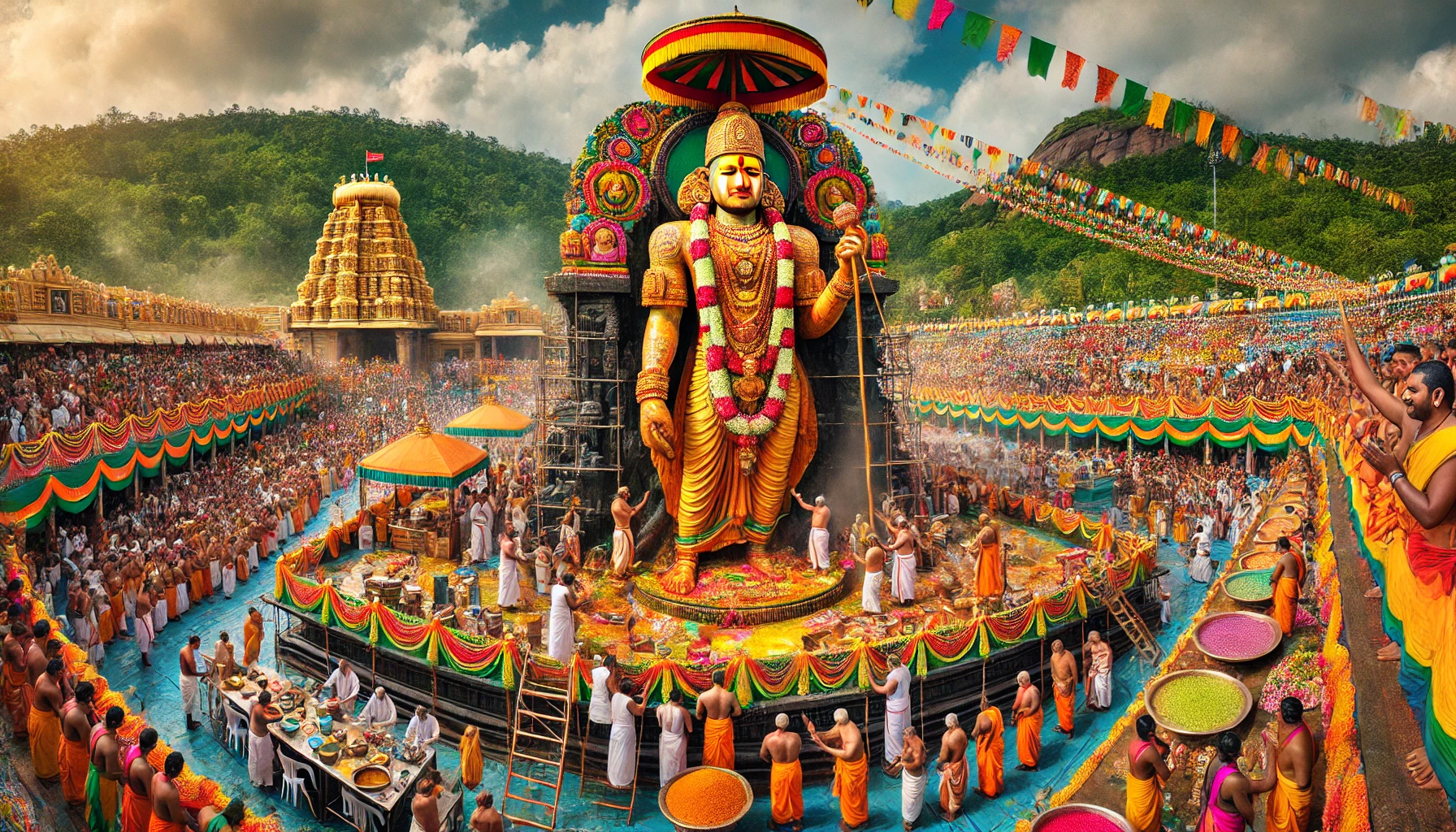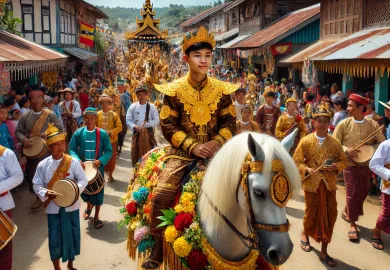
The Mahamastakabhisheka, also known as the Great Head-Washing Festival, is one of the most spectacular and significant religious ceremonies in India. Held once every 12 years in the small town of Shravanabelagola in Karnataka, this grand event honors the towering monolithic statue of Lord Bahubali, also known as Gommateshwara, one of the most revered figures in Jainism. This festival is a unique blend of devotion, culture, and history, attracting devotees and tourists from across the globe.
Shravanabelagola, a serene and picturesque town, transforms into a bustling hub of activity during the Mahamastakabhisheka. The festival is marked by an elaborate ritual of bathing the 57-foot statue of Lord Bahubali with thousands of liters of consecrated water, milk, saffron, and other sacred substances. This ritual, which symbolizes the spiritual cleansing and liberation of the soul, is a powerful testament to the enduring faith of the Jain community and their commitment to preserving their rich heritage.
The Historical and Spiritual Significance of Mahamastakabhisheka
The Mahamastakabhisheka has a deep historical and spiritual significance, rooted in the ancient Jain tradition. The first Mahamastakabhisheka was performed over a thousand years ago, in 981 AD, by Chavundaraya, a minister of the Ganga dynasty. The grand event was initiated to commemorate the consecration of the statue of Lord Bahubali, which is considered one of the largest free-standing statues in the world.
The festival is a crucial event in the Jain religious calendar, symbolizing the victory of the soul over material desires and the attainment of spiritual liberation, known as Moksha. Lord Bahubali, revered for his immense penance and renunciation, represents the ideal of selflessness and non-attachment, which are core principles of Jainism. The Mahamastakabhisheka serves as a reminder of these teachings and inspires devotees to lead a life of purity and righteousness.
Over the centuries, the Mahamastakabhisheka has evolved into a grand celebration that not only highlights the spiritual aspects of Jainism but also showcases the cultural richness and diversity of Karnataka. The festival is a vibrant expression of the artistic, architectural, and cultural heritage of the region, drawing people from all walks of life to witness this awe-inspiring event.
The Rituals and Ceremonies of the Great Head-Washing Festival
The Mahamastakabhisheka is a meticulously organized event, with rituals and ceremonies that span over several days. The main ritual involves the anointing of the statue of Lord Bahubali with various sacred substances, known as ‘Abhisheka.’ This ritual is carried out by Jain priests, who chant mantras and perform intricate ceremonies to invoke the blessings of the deity.
The festival begins with a series of preparatory rituals, including the installation of the Kalashas, or sacred pots, on the scaffolding surrounding the statue. These Kalashas are filled with holy water, milk, sugarcane juice, sandalwood paste, and other sacred substances that are used in the Abhisheka. The main event is the anointing of the statue, which takes place on a specially constructed platform that allows the priests to reach the head of the towering statue.
During the Abhisheka, the statue is bathed with thousands of liters of water, milk, coconut water, sugarcane juice, and other sacred liquids, each representing different virtues and qualities. The ritual culminates in the pouring of saffron, turmeric, vermillion, and sandalwood paste over the statue, giving it a vibrant and colorful appearance. This is followed by the offering of flowers, gold and silver coins, and precious stones, symbolizing the devotion and reverence of the devotees.
The Mahamastakabhisheka is not just a visual spectacle but a deeply spiritual experience for the participants. The ritual of bathing the statue is believed to cleanse the souls of the devotees, bringing them closer to the path of righteousness and spiritual liberation. The festival also includes discourses, prayers, and cultural programs that further enhance the spiritual atmosphere of the event.
The Role of the Jain Community in Preserving the Tradition
The Jain community plays a pivotal role in preserving and organizing the Mahamastakabhisheka. The festival is a massive undertaking that requires meticulous planning and coordination, with contributions from Jain organizations, religious leaders, and volunteers. The community’s commitment to preserving this ancient tradition is evident in the scale and grandeur of the event.
One of the most remarkable aspects of the Mahamastakabhisheka is the collective effort of the Jain community in raising funds for the festival. The event is entirely funded by donations from devotees, who consider it a privilege to contribute to the organization of this sacred ceremony. The funds are used for the construction of the scaffolding, the procurement of sacred substances, and the arrangement of accommodations and facilities for the thousands of pilgrims who flock to Shravanabelagola during the festival.
The Jain community also ensures that the festival is conducted in an environmentally sustainable manner. The use of natural substances for the Abhisheka, such as water, milk, and turmeric, reflects the Jain principles of non-violence and respect for all living beings. The community also takes steps to minimize waste and ensure that the festival leaves a minimal ecological footprint.
In addition to the Mahamastakabhisheka, the Jain community is actively involved in the preservation of the cultural and architectural heritage of Shravanabelagola. The town is home to several ancient Jain temples and monuments, which are maintained and restored by the community. The Mahamastakabhisheka serves as a reminder of the rich legacy of Jainism and the importance of preserving it for future generations.
Experiencing the Mahamastakabhisheka: A Pilgrim’s Journey
For many devotees, attending the Mahamastakabhisheka is a once-in-a-lifetime experience. The journey to Shravanabelagola is a pilgrimage in itself, filled with spiritual significance and a deep sense of devotion. Pilgrims from all over India and abroad travel to the town to participate in the festival and seek the blessings of Lord Bahubali.
The atmosphere in Shravanabelagola during the Mahamastakabhisheka is one of fervent devotion and celebration. The town is adorned with colorful decorations, and the streets are filled with the sounds of devotional music and chants. The sight of the towering statue of Lord Bahubali, resplendent in its newly anointed form, is a sight to behold and leaves a lasting impression on the hearts of the pilgrims.
The festival also provides an opportunity for pilgrims to connect with the larger Jain community and participate in various religious and cultural activities. The discourses and prayers held during the festival offer spiritual guidance and insights into the teachings of Jainism. The cultural programs, including music and dance performances, showcase the rich artistic traditions of Karnataka and add to the festive atmosphere.
For those who are unable to attend the festival in person, the Mahamastakabhisheka is also broadcasted live, allowing devotees from around the world to participate in the rituals and ceremonies. The festival’s global reach reflects the universal appeal of its message and the enduring relevance of the teachings of Lord Bahubali.
Conclusion: The Timeless Legacy of Mahamastakabhisheka
The Mahamastakabhisheka, or the Great Head-Washing Festival, is more than just a religious ceremony; it is a celebration of faith, devotion, and the rich cultural heritage of Jainism. The festival’s significance extends beyond the Jain community, offering a glimpse into the spiritual and cultural traditions of India.
As the Mahamastakabhisheka continues to inspire and attract devotees from across the globe, it serves as a powerful reminder of the timeless teachings of Lord Bahubali and the enduring relevance of Jainism in the modern world. The festival’s grandeur and spiritual depth make it a unique and unforgettable experience, leaving a lasting impact on all who witness it.
In the heart of Shravanabelagola, the towering statue of Lord Bahubali stands as a symbol of spiritual liberation and the triumph of the soul over material desires. The Mahamastakabhisheka, with its elaborate rituals and ceremonies, reinforces this message and invites devotees to embark on a journey of self-discovery and spiritual awakening. As the festival unfolds every 12 years, it renews the faith of the Jain community and ensures that the legacy of Lord Bahubali and the teachings of Jainism continue to inspire future generations.








